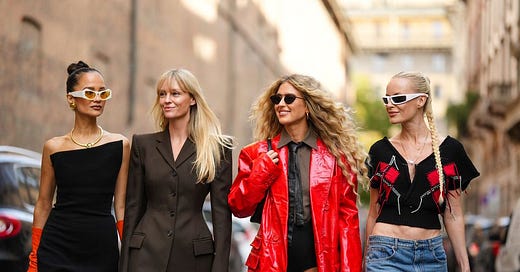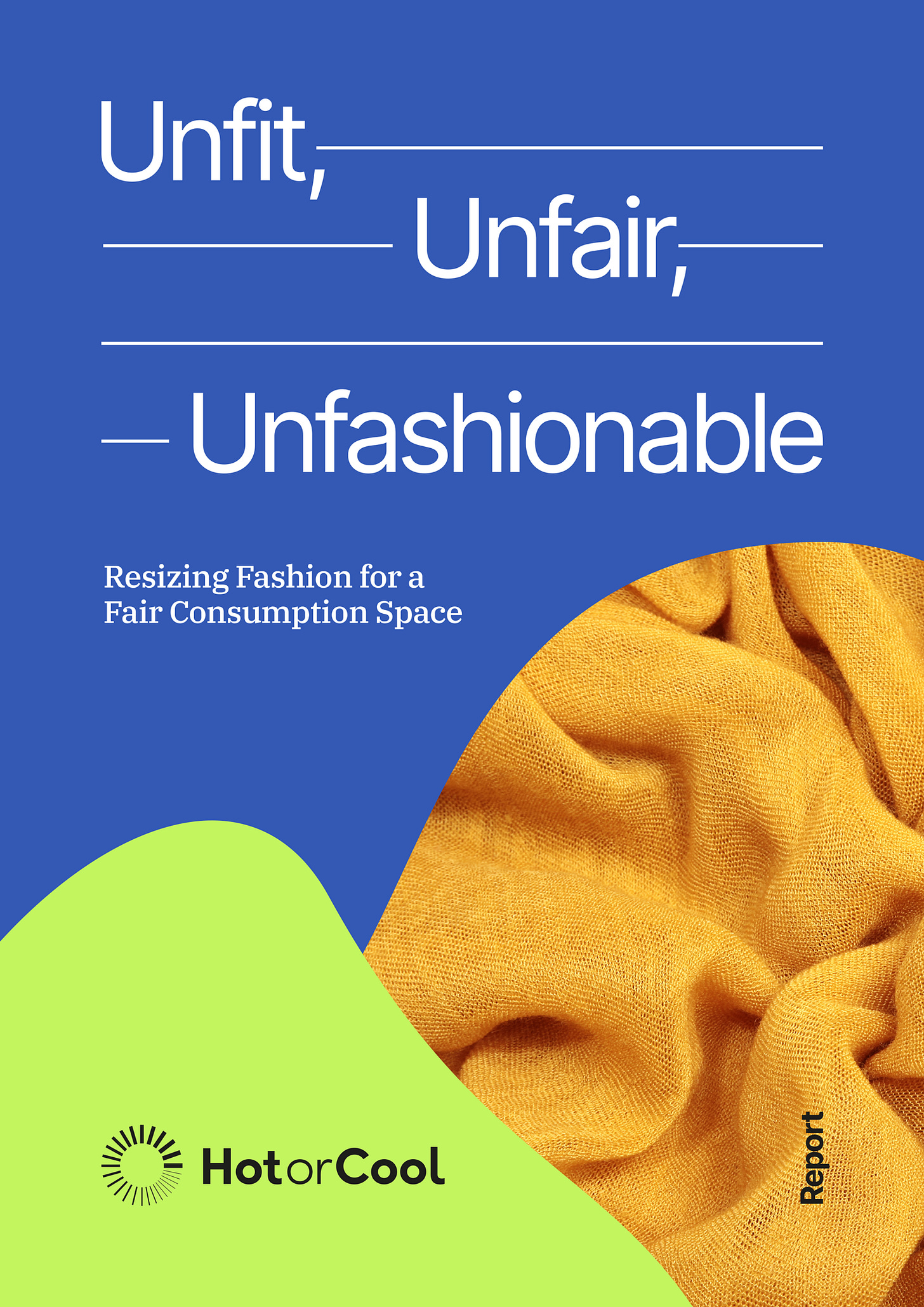November in Fashion, Condensed.
Arizona Muse's climate activism, Vestiaire Collective bans fast fashion, taking the shine off Shein, and when does collaboration become collusion?
This month, I’ve been reflecting a lot on disconnection in the sustainable fashion space. In particular, I’ve noticed this dissonance between the thinkers, the talkers and the doers. All of these groups have the capacity to create change and we’re all working towards the same goal, but there seems to be a huge void between each silo that slows progress and creates tension.
It leads to a situation where fashion activists, unions and NGOs (the doers) feel unsupported and alienated by the industry. Academics and scientists (the thinkers) feel unheard. Brands and those with money (usually the loudest voices) either hoard it at the top or spend it on bandaid solutions and PR projects. I think lot of people in this sector feel frustrated and fatigued by the constant discussion and lack of unified action.
At the start of the month, I was invited to host a panel discussion at the Global Fashion Agenda’s inaugural summit in Singapore. I felt so fortunate to be not only part of the conference, but able to sit in on some fascinating conversations. The summit bought together all of these groups to meet and share solutions to fashion’s biggest challenges, tackling disconnection head-on.
The theme of the summit was all about creating “alliances for a new era”, focusing on the business case for collaboration. And not collaboration in the short-term pilot programme or fun capsule collection kinda way. Collaboration in the wide-scale, emissions-reducing, measurable and accountable kinda way. It felt promising to see decision makers from global brands on a panel with a union leader or renewable energy expert and I hope that it catalysed new partnerships.
Collaboration is clearly the answer to the sustainability sector’s fragmentation, but it isn’t a straight-forward one. The New York Times did a great piece about the blurred lines between collaboration and collusion which I’ve included in the list below, if you want to dive deeper.
As always, I love to hear your thoughts. Hit reply at the end of the email to get in touch!
Until next month,
Meg X
Things I Wrote
Capsule Dressing Does Not Have To Look The Same For Everyone for Harper’s Bazaar.
The capsule wardrobe is often sold as a silver bullet solution for a streamlined and eco-friendly closet. But rarely does it leave room for personal style. In my latest for Harper’s Bazaar, I look into the rise of the capsule wardrobe, minimal “clean girl” style, and how it’s homogenised and lacks inclusivity. While they can be more sustainable than buying into every new trend that hits the high street, they don’t have to all look the same.
Things I Didn’t Write
Is Fashion Making Progress on Climate Change? We Rated 4,000 Brands to Find Out by Sophie Benson for Good on You
When Does Collaboration Become Collusion? by Elizabeth Paton, Ephrat Livni and Jenny Gross for the New York Times
Fashion Brands Grapple With Greenwashing: ‘it’s Not A Human Right To Say Something Is Sustainable’ by Lucianne Tonti for the Guardian
Please Stop Falling for Fashion Microtrends by Izzy Copestake for Vice
Peta Launches $1m Competition To Find Vegan Wool Alternative by Lauren Cochrane for the Guardian
Vestiaire Collective Is Banning Fast Fashion From Its Platform by Sharon Edelson for Forbes
Why Does Fashion Love This Radical Anticapitalist Concept? by Elizabeth Paton for the New York Times
The Price is Wrong. A Visit To Bangladesh’s Clothing Factories Reveals The Problem With Fast Fashion: It’s Too Cheap by J.B. MacKinnon for Sierra Magazine
The To-Do List
Kantamanto Market Fire Fund
This week, a fire broke out in Kantamanto, the world’s biggest secondhand clothing market which is in Accra, Ghana. It destroyed bales of clothing and hundreds of sewing machines used to upcycle clothing. Every week, 15 million garments arrive into the market from around the world and 40% of that is unusable — destined for landfill. The OR Foundation, which works tirelessly to deal with the world’s clothing waste at Kantamanto market, has set up a relief fund to help rebuild the destroyed section of the market and support the impacted traders. You can learn more about Kantamanto above and donate to the fund below.
Live Well Be Well Podcast: Earth Health, Reinvention & Climate Activism with Arizona Muse (56 min)
I didn’t know much about model-turned-activist Arizona Muse before listening to this podcast interview, but her story is really interesting. Muse is the founder of Dirt Charity, which focuses on regenerative and biodynamic agriculture, so she also discusses the food industry and nutrition in this episode. Click the image above to watch the conversation on Youtube or click below to listen.
Greenpeace report: Taking the Shine off Shein.
This new Greenpeace report found that 15% of Shein products tested for hazardous chemicals contained levels in excess of EU regulatory limits. This includes super high levels of phthalates (a toxic chemical linked to infertility, cancer, asthma and more) plus formaldehyde, lead and nickel.
Inside the Boohoo Warehouse Where Workers Call Themselves Slaves (6 min)
The Times has done some great reporting around the conditions inside fast fashion factories, including this exposé of Boohoo. Nothing new here - Boohoo was found guilty of terrible conditions and paying workers £3.50/hour back in 2020 - but it’s interesting to see that nothing has changed since then. What will it take?
Unfit, Unfair, Unfashionable. Resizing Fashion for a Fair Consumption Space.
A new report from the Hot or Cool Institute came out last week, all about overconsumption of clothing. It breaks down exactly how many items of clothing we actually need, and how we can reduce clothing consumption to live comfortably within 1.5-degree global warming targets. An interesting conclusion: “If no other actions are implemented, such as repairing/mending, washing at lower temperatures, or buying second-hand, purchases of new garments should be limited to an average 5 items per year.” Thoughts?
Thank you for reading the Titian Thread Newsletter! To subscribe or share with a friend, hit the buttons below.









I agree with you whole-heartedly. Collaboration is the only way forward in the sustainability conversation, but it requires brands, agencies or organizations to be specific & honest with what they are best at. A couple of encouraging examples in the US: 1) The brand ForDays is offering their "Take Back Bag" as a recycling service and inviting other brands to use it as well to fast track their circularity efforts, and 2) my brand KNOWN SUPPLY is offering fair trade and sustainable custom merchandise to all types of organizations, so anyone can sell Fair Trade Certified merchandise.
Kia ora Megan - really enjoyed my first read of your work - elevating the dysfunction within the industry even from the well meaning / intentioned side is well worth highlighting in my opinion.
Similarly the collusion, greenwashing and greenwashing needs constant presence in front of consumers imho as they quickly forget and revert to previous behaviour.
Thanks for your work and sharing !
Ngā mihi nui
J